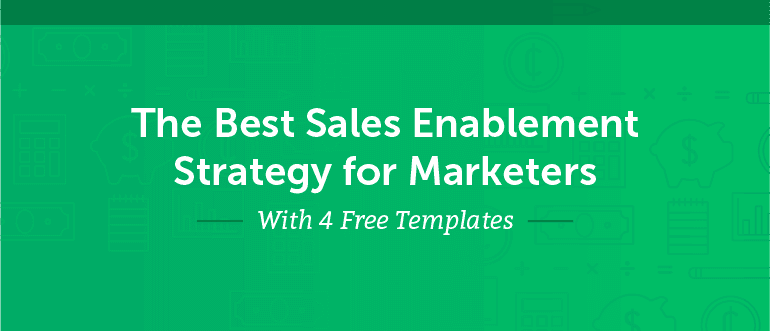
Sales and Marketing share the same goals.
Both are working toward bringing in new customers.
Yet, *a lot* of companies struggle to align Sales and Marketing….
Communication is broken and there is little or no collaboration.
Sound familiar?

(Slowly raises hand.)
Your marketing team is pumping out great content…
BUT your sales team doesn’t know it exists, where to find it, or how it can help close deals.
Maybe you’ve even wasted precious time creating multiple versions of the same document because teams simply don’t know how to find what they’re looking for.
That’s where sales enablement comes in.
Aligning your sales and marketing teams might sound like a herculean feat, but with a solid sales enablement strategy and a little tenacity, you can improve the ROI on your marketing content AND help your sales team be more successful.
The good news is you don’t have to do it alone.
You’ll find everything a Marketing Manager needs to know about sales enablement right in this post.
Download our Free Sales Enablement Templates
Before we dive into the how-to, download our free templates. They’ll help you get your strategy in order AND bring your team onboard.
You’ll find:
- A change management strategy template to help with the transition.
- A content audit guide to help identify your content deficits.
- A business case template to help you pitch a sales enablement strategy.
- A content mapping template to map your content to each funnel stage.
What is Sales Enablement and Why Should a Marketer Care?
Sales enablement isn’t a new topic…
But it has been gaining traction over the past few years.
Here’s a stat to illustrate:
In 2017,
59% of companies indicated that they had a dedicated enablement person, program, or function. In 2016, that number was 19%.
That’s a 210% increase in just one year.
[Tweet “There was a 210% increase in companies adopting sales enablement between 2016 and 2017. Here’s what you need to know as a Marketer.”]
If you’re new to the term, here’s the “official” definition:
“Sales enablement is a process carried out between sales, marketing, and other areas of a company to more effectively produce content, knowledge, and tools to be used throughout the sales cycle.”
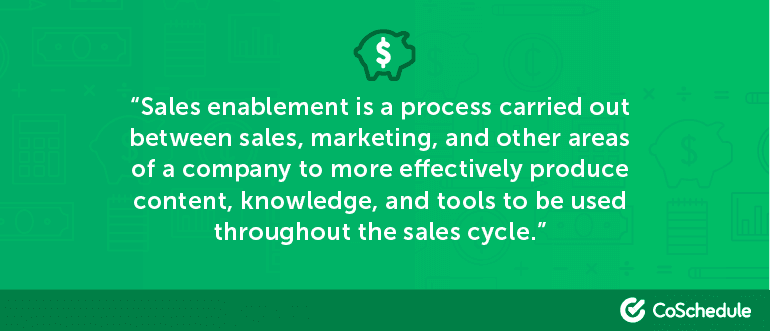
Put another way, sales enablement focuses on these core elements:
- Sellers have access to the right content at the right time.
- Improved collaboration between marketing and sales.
- Ongoing training to help sales staff deliver on the bottom line.
- Analytics to understand how content resonates with potential customers, then iterating on it for constant improvement.
Sales teams are the primary benefactors of a sales enablement strategy, but marketers play an important role in its implementation and continued success.
That said, however, marketers aren’t without benefit.
Us marketers are always trying to prove the value of what we do.
When a piece of content your marketing team created helps close a new sale… that’s a pretty great way to attribute value and prove ROI.
[Tweet “What is sales enablement and why should marketers care?”]
So What’s a Marketer’s Role in Sales Enablement?
Sales enablement isn’t owned by the marketing department, but they do play an important role in the function.
A marketer’s role in sales enablement can consist of the following elements:
- Proposing a sales enablement strategy - Marketing Managers should be deeply involved in the sales enablement proposal from the start. Being proactive from the beginning shows initiative and that you have the vision to move the company in the right direction.
- Sharing customer insights - No one knows the customer or buyer journey better than you. Share this info with your sales team (or sales enablement team if your company has a dedicated team for this). You should lead the charge on creating a unified buyer persona, pain points, and value proposition that is understood by everyone in the organization. That’s your wheelhouse, marketer.
- Content mapping and audit - Your team will initiate a mapping exercise to identify content deficits and build a content production plan to fill these gaps with high-quality, customer-facing content.
- Providing a smooth transition from marketing to sales in the customer journey - Think of it as a relay race. As an individual moves further down the marketing funnel, the baton will be passed from marketing to sales.
As the baton gets passed, the marketing team needs to provide the sales team with the right gear to cross the finish line.
(The right gear being content in this analogy... more on this later.)
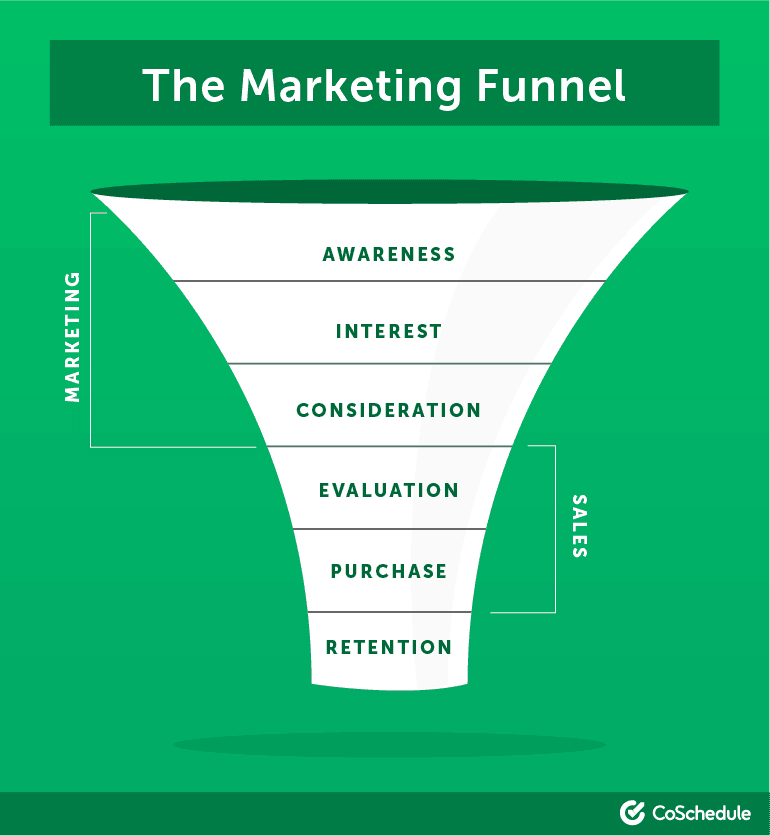
Take a look at the marketing funnel. The upper half is owned by marketing departments where work is done on generating awareness and interest. The batton gets passed to sales typically in the consideration/evaluation phase.
The lower half is owned by the sales department.
Marketing assists sales in converting customers by providing the right marketing assets to effectively engage and educate buyers.
Why is Sales Enablement Important?
“Sales” has changed a lot in the last 15 years.
Buyers today are informed…
Because it’s easier than ever to be.
Information is a-plenty and purchase decisions can be made without ever engaging with the sales department.
Which means sales departments have had to shift their focus toward adding value and insight to the purchase process - rather than the strongarm “always be closing” tactics reminiscent of something in Glengarry Glen Ross.

This new reality means your sales team needs to have access to the right content at the right time…
But storage systems are disjointed and it’s *nearly* impossible for sales team members to find the documents they need.
So they either gather their “go-to” documents on their hard drives, even if those documents are out-of-date and ineffective.
OR they put in requests to the marketing team to have new materials made that fit their needs without knowing if the content already exists.
Marketing has no visibility into what sales is doing and sales has no visibility into the marketing roadmap.
Sales enablement bridges these gaps.
Solve Your Visibility Issues With CoSchedule
What if you could easily share your marketing roadmap, timelines and project plans with members of your sales staff without lengthy emails, constant check-ins, and complaints that things are taking too long?
That reality is possible.
With CoSchedule’s read-only function, you can easily share your marketing roadmap with other departments (like sales) without …
- Paying for additional users.
- Taking a bunch of static screenshots.
- Or spending countless hours putting together slide decks.
All you have to do is create a read-only link in CoSchedule and share it with your sales team.

After you’ve shared the link to your calendar…it updates in real-time when you make changes.
Which means you only need to share the link ONCE (instead of a thousand times after every single update).
This gives your sales team true visibility into timelines and delivery dates of their collateral, as well as the ability to see what types of materials have already been requested.
Maybe you only want your sales team to see sales related marketing projects… not *everything* your team is working on.
No problem.
Simply create a saved view by filtering out everything but marketing projects related to sales.
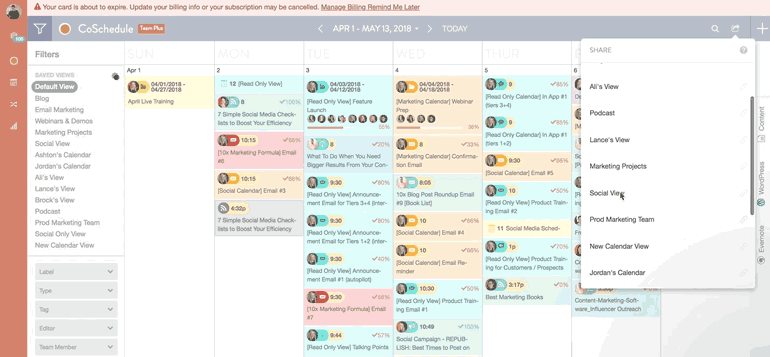
Boom.
You’ve just solved a few sales enablement hurdles with a couple clicks.
Sales Enablement Benefits
Getting a successful sales enablement strategy off the ground is no easy task.
But the benefits outweigh the trouble.
If you (or your boss) still need some convincing, here are some of the major benefits to implementing a sales enablement strategy.
Increased ROI on Content
According to an article by
Forbes, 60 to 70% of content produced by B2B marketing organizations goes unused.
One of the outcomes of a sales enablement strategy is a centralized portal for all your content items… which means they are more likely to get used.
[Tweet: “60 to 70% of content produced by B2B marketing organizations goes unused. Improve the ROI on your content with this sales enablement strategy.”]

Improved Analytics and Reporting
What team doesn’t want better insights into what type of content resonates with prospects?
Analytics from sales enablement can help you measure content performance, to determine what works and what doesn’t.
Your Sales Team Will Close More Deals
Firstly, salespeople are only spending
35.9% of their time selling, with the rest of their time spent on admin tasks on other non-selling related issues.

[Tweet: “Salespeople are only spending 35.9% of their time selling. Use this sales enablement strategy to fix it.”]
Secondly, sales teams need quick access to information. No time to waste scavenging for collateral.
Sales teams who respond to a lead within
one hour are seven times more likely to qualify the lead than those who waited an extra hour. They were also 60 times more likely than those who waited 24 hours.
Implementing a sales enablement strategy means less time wasted tracking down documents, so your sales team can spend more time *actually* selling.
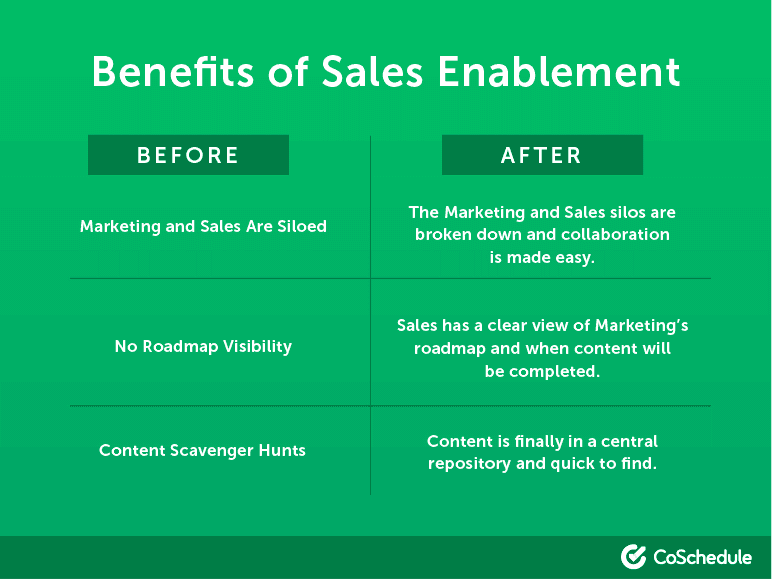
How to Plan An Effective Sales Enablement Strategy
Step 1: Find Operational Strengths and Weaknesses
This step aims to determine how and where your company can benefit from implementing a sales enablement strategy.
Do sales reps have the content they need?
If not, this indicates that you either have content gaps that need to be filled OR there is an issue with getting the content into the hands of the sales team.
Is existing content outdated?
Outdated sales materials mean that your reps aren’t communicating with prospective customers in the most effective way. For example,
sending out a case study that is five years old does not create a great first impression. This indicates there are collaboration inefficiencies between marketing and sales.
Are materials getting used?
If materials are not getting used, there is either an issue in the relevance of the materials your marketing team is producing or in the location in which they are stored.
Are materials being modified by sales reps?
This indicates that it is difficult for sales teams to get the necessary resources from the marketing team. If it’s easier for a sales rep to alter and create their own documents, there is clearly something broken in the request process or the length of production.
All of these questions are good indicators that your company could benefit from a sales enablement strategy.
Step 2: Make a Business Case
A sales enablement strategy certainly can’t be boiled down to an oversimplified business case, but it’s a good place to start when attempting to get executive buy-in.
It shows that you have thoroughly considered the problem and how the solution will contribute to the company’s overall strategy and goals.
You’re creating awareness for the problem and presenting the solution on a silver platter.
Make sure your business case is clear, concise, and tied to metrics and goals.
Step 3: Nail Down your Personas
Before embarking down a sales enablement process, you’ll want to have a very clear view of who your customers are.
Collaborate with the sales team and formulate your ideal customers.
This will assist your marketing team in producing content that resonates as individuals move down the funnel.
The sales team has a direct line into how potential customers’ articulate their pain points, what solutions they are looking for, and the language they use. This is great info for marketers to take into account when producing sales enablement content.
Involving the sales team also means you’re more likely to produce content that is fit for purpose…
Meaning it’s more likely to get used in the first place.
Step 4: Perform a Content Audit
The next step, and probably one of the most important ones from a marketer’s perspective, is the content audit.
During this step, you’ll map out existing content and identify content deficits. You can also identify materials that need updating during this step.
It’s often helpful to map content against the marketing funnel and against the specific industries you target.
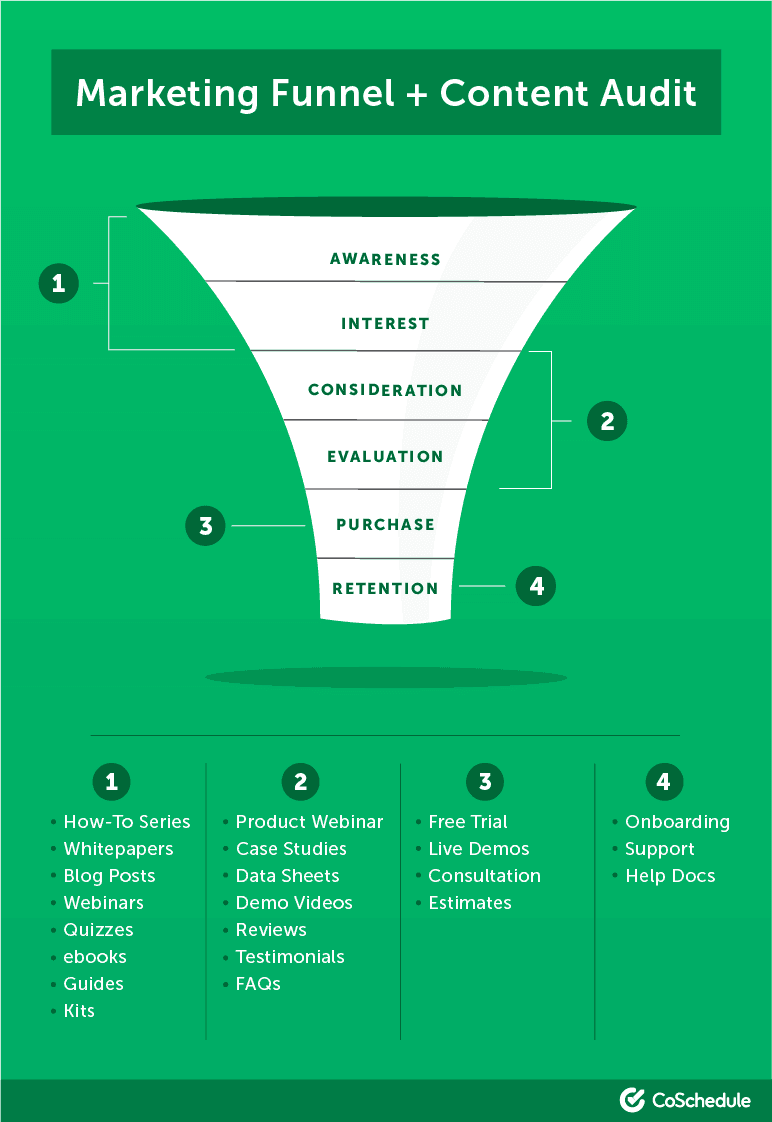
Step 5: Content Organization
Next, strategize a central location for sales content storage.
It should be where a sales rep can find, use, and share content.
One helpful functionality is the ability to tag content by industry, buyer stage, opportunity level, etc. This makes it easier for salespeople to find the right content at the right time – increasing efficiency and productivity.
Content libraries can be organized in a Google Drive, Dropbox, an intranet, or in a CRM like Salesforce. Sync with your sales department to understand what is most convenient for them.
Keeping track of what type of content is being produced and when can be a challenge for Marketing Managers.
Once your content audit is finished and the file organization has been sorted out, it’s important to make sure it *stays* that way.
You don’t want your content plan to go pear-shaped after you’ve put in all that hard work.
CoSchedule Tagging Makes Content Planning a Breeze
CoSchedule allows you to tag projects and content items so you can see exactly where projects fit into your master plan.
To add a tag to a project, open any project on the calendar.
Underneath the project's title, begin to type the tags you want to add to your project.
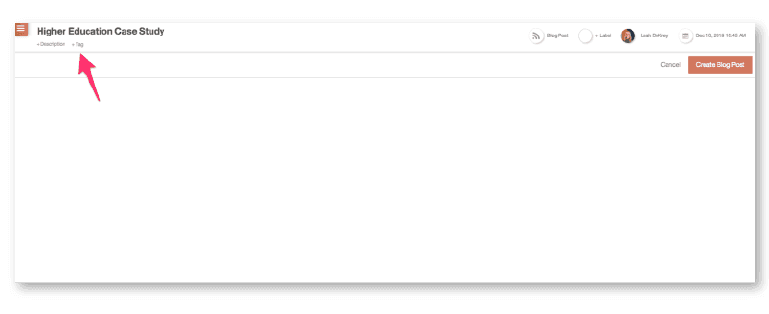 Add tags
Add tags like:
- TOFU, MOFU, BOFU
- Industry
- Content type
- Department
- Sales Enablement
- Etc.
Then create a saved view so you can always find exactly what you need…
When you need it.
To create a saved view, hover over the hamburger menu and choose the option “Create new saved view”.

Name your saved view. In this example, I’m going to create a saved view for all the content that is tagged as sales enablement.

Add a filter category and choose “tag”.

Then, choose the sales enablement tag.

Now you have a custom calendar view of all the sales enablement content your team is working on.

No more sifting through massive spreadsheets just to give an update on your sales enablement content strategy.
You can see exactly how your team is contributing and when projects are due.
Step 6: Analytics
As if you don’t hear enough about analytics, amiright?
But, it is an important part of any sales enablement strategy.
Analytics offers sales and marketing the chance to iterate and constantly improve their processes.
The reporting you do answers important questions about content effectiveness, its usage rate, which content generated the most engagement, if it is triggering a buying decision, and how much business value you are getting from it.
Here are a few things you should be tracking with sales enablement reporting.
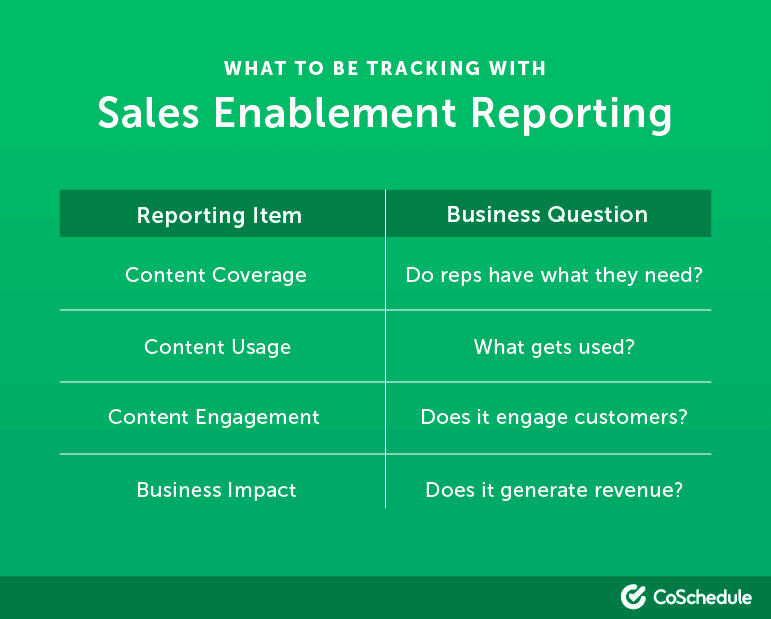
Streamline All Your Marketing Projects with CoSchedule
Now that you know everything a marketer needs to know about sales enablement….
You’re equipped with a bunch of free templates…
AND you have a step-by-step process to guide your sales enablement implementation...
It’s time to start collaborating with your sales team to crush 2019’s goals.

 Sales and Marketing share the same goals.
Both are working toward bringing in new customers.
Yet, *a lot* of companies struggle to align Sales and Marketing….
Communication is broken and there is little or no collaboration.
Sound familiar?
Sales and Marketing share the same goals.
Both are working toward bringing in new customers.
Yet, *a lot* of companies struggle to align Sales and Marketing….
Communication is broken and there is little or no collaboration.
Sound familiar?
 (Slowly raises hand.)
Your marketing team is pumping out great content…
BUT your sales team doesn’t know it exists, where to find it, or how it can help close deals.
Maybe you’ve even wasted precious time creating multiple versions of the same document because teams simply don’t know how to find what they’re looking for.
That’s where sales enablement comes in.
Aligning your sales and marketing teams might sound like a herculean feat, but with a solid sales enablement strategy and a little tenacity, you can improve the ROI on your marketing content AND help your sales team be more successful.
The good news is you don’t have to do it alone.
You’ll find everything a Marketing Manager needs to know about sales enablement right in this post.
(Slowly raises hand.)
Your marketing team is pumping out great content…
BUT your sales team doesn’t know it exists, where to find it, or how it can help close deals.
Maybe you’ve even wasted precious time creating multiple versions of the same document because teams simply don’t know how to find what they’re looking for.
That’s where sales enablement comes in.
Aligning your sales and marketing teams might sound like a herculean feat, but with a solid sales enablement strategy and a little tenacity, you can improve the ROI on your marketing content AND help your sales team be more successful.
The good news is you don’t have to do it alone.
You’ll find everything a Marketing Manager needs to know about sales enablement right in this post.
 Put another way, sales enablement focuses on these core elements:
Put another way, sales enablement focuses on these core elements:
 Take a look at the marketing funnel. The upper half is owned by marketing departments where work is done on generating awareness and interest. The batton gets passed to sales typically in the consideration/evaluation phase.
The lower half is owned by the sales department.
Marketing assists sales in converting customers by providing the right marketing assets to effectively engage and educate buyers.
Take a look at the marketing funnel. The upper half is owned by marketing departments where work is done on generating awareness and interest. The batton gets passed to sales typically in the consideration/evaluation phase.
The lower half is owned by the sales department.
Marketing assists sales in converting customers by providing the right marketing assets to effectively engage and educate buyers.
 This new reality means your sales team needs to have access to the right content at the right time…
But storage systems are disjointed and it’s *nearly* impossible for sales team members to find the documents they need.
So they either gather their “go-to” documents on their hard drives, even if those documents are out-of-date and ineffective.
OR they put in requests to the marketing team to have new materials made that fit their needs without knowing if the content already exists.
Marketing has no visibility into what sales is doing and sales has no visibility into the marketing roadmap.
Sales enablement bridges these gaps.
This new reality means your sales team needs to have access to the right content at the right time…
But storage systems are disjointed and it’s *nearly* impossible for sales team members to find the documents they need.
So they either gather their “go-to” documents on their hard drives, even if those documents are out-of-date and ineffective.
OR they put in requests to the marketing team to have new materials made that fit their needs without knowing if the content already exists.
Marketing has no visibility into what sales is doing and sales has no visibility into the marketing roadmap.
Sales enablement bridges these gaps.
 After you’ve shared the link to your calendar…it updates in real-time when you make changes.
Which means you only need to share the link ONCE (instead of a thousand times after every single update).
This gives your sales team true visibility into timelines and delivery dates of their collateral, as well as the ability to see what types of materials have already been requested.
Maybe you only want your sales team to see sales related marketing projects… not *everything* your team is working on.
No problem.
Simply create a saved view by filtering out everything but marketing projects related to sales.
After you’ve shared the link to your calendar…it updates in real-time when you make changes.
Which means you only need to share the link ONCE (instead of a thousand times after every single update).
This gives your sales team true visibility into timelines and delivery dates of their collateral, as well as the ability to see what types of materials have already been requested.
Maybe you only want your sales team to see sales related marketing projects… not *everything* your team is working on.
No problem.
Simply create a saved view by filtering out everything but marketing projects related to sales.
 Boom.
You’ve just solved a few sales enablement hurdles with a couple clicks.
Boom.
You’ve just solved a few sales enablement hurdles with a couple clicks.

 [Tweet: “Salespeople are only spending 35.9% of their time selling. Use this sales enablement strategy to fix it.”]
Secondly, sales teams need quick access to information. No time to waste scavenging for collateral.
Sales teams who respond to a lead within one hour are seven times more likely to qualify the lead than those who waited an extra hour. They were also 60 times more likely than those who waited 24 hours.
Implementing a sales enablement strategy means less time wasted tracking down documents, so your sales team can spend more time *actually* selling.
[Tweet: “Salespeople are only spending 35.9% of their time selling. Use this sales enablement strategy to fix it.”]
Secondly, sales teams need quick access to information. No time to waste scavenging for collateral.
Sales teams who respond to a lead within one hour are seven times more likely to qualify the lead than those who waited an extra hour. They were also 60 times more likely than those who waited 24 hours.
Implementing a sales enablement strategy means less time wasted tracking down documents, so your sales team can spend more time *actually* selling.


 Add tags like:
Add tags like:
 Name your saved view. In this example, I’m going to create a saved view for all the content that is tagged as sales enablement.
Name your saved view. In this example, I’m going to create a saved view for all the content that is tagged as sales enablement.
 Add a filter category and choose “tag”.
Add a filter category and choose “tag”.
 Then, choose the sales enablement tag.
Then, choose the sales enablement tag.
 Now you have a custom calendar view of all the sales enablement content your team is working on.
Now you have a custom calendar view of all the sales enablement content your team is working on.
 No more sifting through massive spreadsheets just to give an update on your sales enablement content strategy.
You can see exactly how your team is contributing and when projects are due.
No more sifting through massive spreadsheets just to give an update on your sales enablement content strategy.
You can see exactly how your team is contributing and when projects are due.




